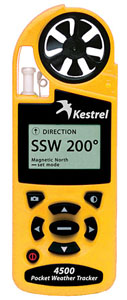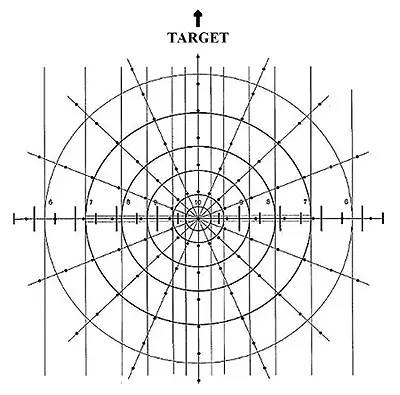|
The Kestrel 4500 Pocket Weather Tracker  Have you ever heard the saying, �it�s hard to make a good thing better�? Well, the folks at Nielson Kellerman have done just that. While the Kestrel 3500 Pocket Weather Meter is a great tool for the outdoorsman, the K4500 is amazing. The Kestrel 4500 records critical weather information for the outdoorsmen, wilderness hunter, boating enthusiast and airplane pilot. The information can be stored for later recall or uploaded to a computer with the optional N-K interface. I haven�t been behind the controls of an aircraft in over thirty years or worked as a commercial fisherman in fifty years. However, I can tell you that the K4500 would have saved me a lot of grief if it had been around then. I might not have been required to make an emergency landing due to bad weather or radio the US Coast Guard for assistance in a major squall. If any of you reading this plan to venture far from shore in your boat or fly private aircraft, you should give serious consideration to this device. If you venture into the wilderness as a hiker or hunter, the K4500 is a �must have.� The primary purpose of this article is to evaluate the usefulness of the K4500 for the target shooter and hunter. The Kestrel 4500 isn�t cheap, with a MSRP of $399. However, as with the K3500, there are dealers like Sinclair on the internet discounting it as low as $312. Considering what this device is capable of doing, that is a very good price. The K4500 is actually a small computer with sensors to record, analyze and store the environmental data it receives. It allows you to save up to 1,400 data points for future reference. That feature alone makes it worth the extra money. For the target shooter, it allows you to go back and check conditions from previous matches for comparison to your current one. It sure beats having to find your notes from last years competition among all of the papers that most target shooters accumulate. If you were not one to keep adequate records from one match to the next, the K4500 now makes that task simple and reliable. No more excuses, no more wishing you had kept better records and no more lost records. The most useful features of the K4500, from the shooter�s viewpoint, are the crosswind/headwind features. Ok, I know, you can use K3500 to measure the wind speed and estimate the direction before you begin shooting, right? Because the flags down range are moving in different directions, you mentally calculate the average deviation effect. For a master-level shooter, that works fine. For the average shooter, there has to be a better way. At this point, enter Hans Prinz of Albuquerque, New Mexico. Hans has developed a program (not yet on the market, but I am working on him) that generates a wind chart for the altitude, bullet weight, ballistic coefficient and velocity of the load you are shooting. The black dots on the chart below are wind adjustments for each compass heading-vector. Depending on the velocity and shooting distance, they represent 1 mph or 2 mph wind increments. We plot each shot on the chart and make the appropriate adjustments for the next round. The wind chart below was prepared by Hans for the 600 yard range at Zia Rifle and Pistol Club in Albuquerque. It is specific for my 6.5x284 round; i.e., a Lapua 139 grain Scenar with a muzzle velocity of 2945 fps. The dots on each vector line are 2 mph wind increments on this chart. For example, given a wind of 8 mph from the NE (assuming that you are shooting towards the north), you move out to the 4th dot (edge of the 7-ring), then drop straight down to the horizontal base line and hold off-target at that point to compensate for the wind.  Until the K4500 was introduced, shooters had to estimate the crosswind speed and direction. Even with a wind chart, there was a high degree of error in the estimates. In order to ensure that the K4500 was given a thoroughly objective test, I decided to do the field testing with my daughter�s Savage 6.5x284. An experienced target shooter might subconsciously compensate for the wind based on their experience, even though I asked them to use the chart and K4500. As such, I would not be sure that the results represented the data provided by the Kestrel or the intuition and experience of the shooter. For me, with minimal (translate that to zero) long range shooting experience, I would have to rely completely on the K4500 for crosswind values. Because the direction of the target is not always pointing north, I added a compass diagram next to my wind charts. I take my Kestrel readings, mark them on the compass diagram and then transfer them to the appropriate vector on the wind chart. We got up to leave for the Zia range at o�dark thirty, about 0530, much too early for my liking. However, we�re expected to be at the range by seven-fifteen, so after three cups of coffee, my wife and I piled into her truck and headed north. Thank goodness Mary likes to drive, as it gives me time to down some more coffee and get my body into first gear. September in New Mexico is infamous for its changeable weather. It can feel as cold as an Alaskan winter in the morning and hotter than Death Valley by noon. The temperatures this morning were in the mid 50�s, ideal for shooting, at least for the first hour or so. After that, the winds come up, the sun begins to generate a mirage and the bugs come out to play. Sometimes I wonder why, being retired, I put myself through this. As we unloaded at the range, Mary looked at me and asked, �Are we having fun yet?� Mary drew the first relay, lucky her, no wind. With my usual luck, I drew the second relay, just about the time the wind was picking up. After all, I was there to test the crosswind feature of the K4500, so I was going to get my chance. At the Zia range, we shoot to the east, just about into the rising sun. The guy that designed that setup needs swift kick in the head. When it came my turn to shoot, I brought out the K4500 and took my readings. Several of the other shooters gave me a rather nasty look, as if to say, why didn�t you do that for us. The K4500 indicated that the wind was coming from the SE at a steady 8 mph. I marked the SE vector on my compass diagram in red and transferred that to the wind chart. The rest, as they say, is history. Even though it was uncomfortable for me to lie on the ground at the tender age of 69, it was great. I now thoroughly understood everything that F-class shooters have been telling me the past two years. The mirages, the boils, the wind effects and the thrill of getting an "X." Incredible! But, I digress. How did I do with the help of the K4500 compared to the other shooters? I shot a 194/200 at 600 yards. I wasn�t high, but I was by no means anywhere near the bottom. The K4500, coupled with Hans� wind chart, allowed me to compensate and hold at the appropriate point on the target. The six points that I dropped were 9�s, just barely out of the center. I believe that one can honestly attribute them to the fact that this was my first time shooting, not only this rifle, but also at 600 yards lying on the ground. I would hate to imagine what my score would have been without the aid of the K4500. For those of you who remember my article on the K3500, it also provides wind speed, but no direction. And yes, I probably could have taken a wind speed reading with the K3500 and made an educated guess as to the direction and plotted the same information. However, it was so easy with the K4500. Hold it up, read the wind speed and direction, then plot the values. Why estimate when you can be exact? The ease of use and simplicity of the K4500 makes it well worth the price. As stated earlier, I can imagine a myriad of other uses, but for now I will use the K4500 when Mary and I shoot F-Class. However, I�ll keep my K3500 as a backup, just in case. For the record: Military sharpshooters from several countries use the K4500 as �standard issue�. If you buy the K4500, you won�t leave home without it. And my wife? I knew you were going to ask. She beat me by one point and slammed me on the X-count. Imagine what she�d have done if I�d let her use the K4500? Tomorrow is another day and another match is coming up. The specifications for the Kestrel 4500 Pocket Weather Tracker are as follows:
| ||||||||||||||||||||||||||||||||||||||||||||||||||||||||||||||||||||||||||||||||||||||||||||||||||||||||||||||||||||||||||||||||||||||||||||||||||||||||||||||||||||||||||||||||||||||||||||||||||||||||||||||||||||||||||||||||||||||||||||||||||||||||||||||||||||||||||||||||||||||||||||||||||||||||||||||||||||||||||||||||||||